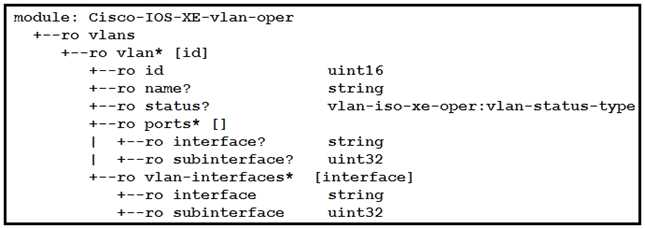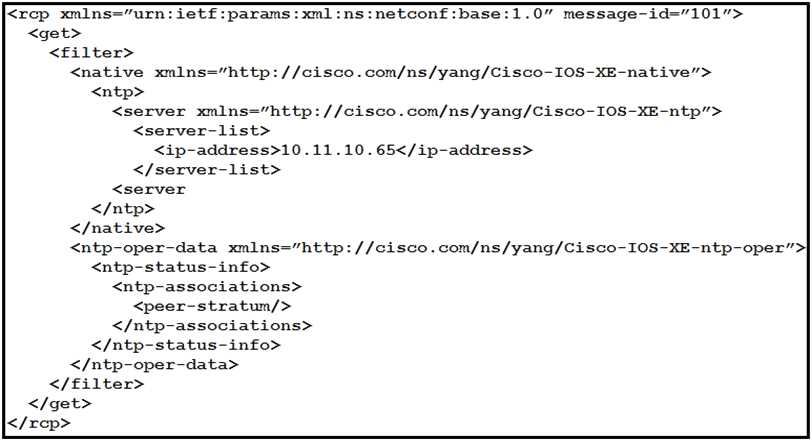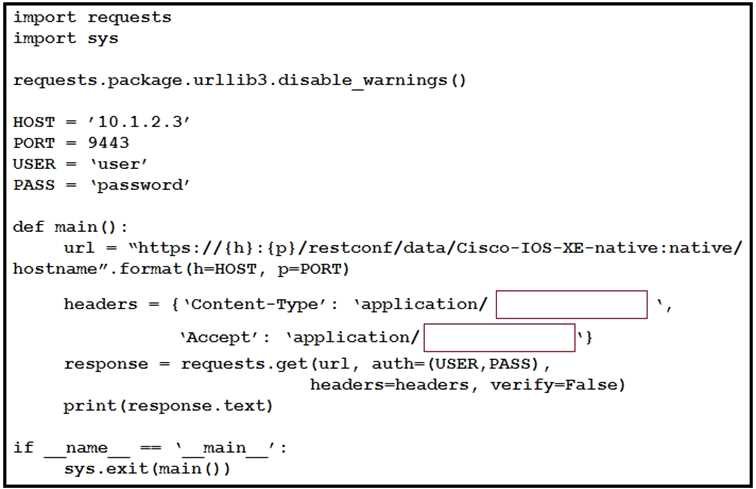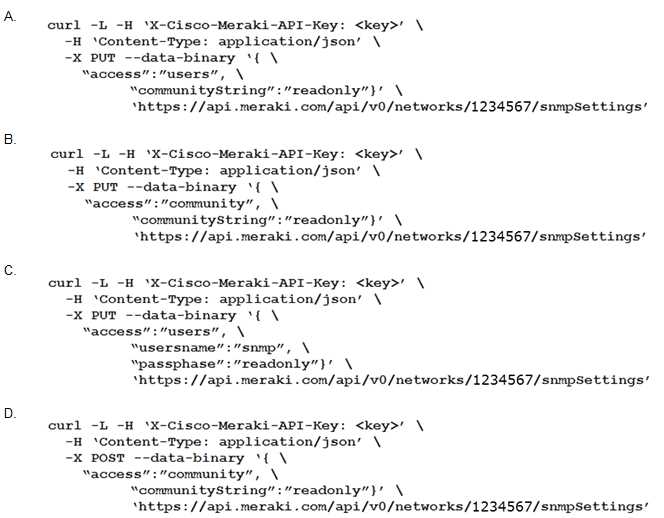Question 1
Refer to the exhibit.
Which NETCONF protocol operation is used to interact with the YANG model?
- A. <edit-config>
- B. <get>
- C. <get-config>
- D. <copy-config>
Answer:
B
Explanation:
Reference:
https://www.cisco.com/c/en/us/td/docs/routers/crs/software/crs-r6-
4/programmability/configuration/
guide/b-programmability-cg-crs-64x.pdf
Comments
Question 2
Refer to the exhibit.
How many YANG models does the NETCONF <get> operation interact with?
- A. one
- B. two
- C. three
- D. four
Answer:
B
Explanation:
:
The get operation tag is at the beginning of the document. It interacted only with NTP and its related
services. There get operation interacted only with one model.
Comments
Question 3
Which statement describe the difference between OpenConfig and native YANG data models?
- A. Native models are designed to be independent of the underlying platform and are developed by vendors and standards bodies, such as the IETF.
- B. Native models are developed by individual developers and designed to apply configurations on platforms.
- C. OpenConfig models are developed by vendors and designed to integrate to features or configurations that are relevant only to that platform.
- D. Native models are developed by vendors and designed to integrate to features or configurations that are relevant only to that platform.
Answer:
D
Explanation:
Reference:
https://www.cisco.com/c/en/us/products/collateral/switches/nexus-9000-series-switches/white-paper-c11-741518.html
Comments
Question 4
Refer to the exhibit.
An engineer creates a Python script using RESTCONF to display hostname information. The code
must be completed so that it can be tested. Which string completes the highlighted areas in the
exhibit?
- A. yang-data+json
- B. yang +json
- C. yang.data+json
- D. json
Answer:
A
Explanation:
Reference:
https://www.cisco.com/c/en/us/td/docs/ios-xml/ios/prog/configuration/166/b_166_programmability_cg/restconf_prog_int.html
Comments
Question 5
Which statement is true for Cisco IOS XE Software?
- A. RESTCONF supports JSON and XML and NETCONF supports XML.
- B. RESTCONF supports XML and NETCONF supports JSON and XML.
- C. RESTCONF and NETCONF supports JSON and XML.
- D. RESTCONF supports XML and NETCONF supports JSON.
Answer:
A
Explanation:
Reference:
https://www.cisco.com/c/en/us/td/docs/ios-xml/ios/prog/configuration/169/b_169_programmability_cg/restconf_programmable_interface.html
Comments
Question 6
Which curl command is used to update the SNMP community of network ID “1234567” to read-only?
- A. Option A
- B. Option B
- C. Option C
- D. Option D
Answer:
B
Explanation:
:
PUT is used to update the snmp network ID. The access has to be community and not users.
Therefore, option B is correct.
Comments
Question 7
Refer to the exhibit.
Which NETCONF statement type is represented by +--rw address* [ip]?
- A. list
- B. leaf-list
- C. container
- D. submodule
Answer:
A
Explanation:
:
Symbols after data node names: "?" means an optional node, "!" means a presence container, and
"*" denotes a list and leaf-list.
Comments
Question 8
The automation engineer must replace device configuration using RESTCONF. How is this configured
using
the Python library Requests?
- A. delete()
- B. post()
- C. put()
- D. patch()
Answer:
C
Explanation:
Reference:
https://www.cisco.com/c/en/us/td/docs/ios-xml/ios/prog/configuration/166/b_166_programmability_cg/restconf_prog_int.html
Comments
Question 9
Which two Netmiko methods are used to configure a device? (Choose two.)
- A. send_config()
- B. send_control_from_file()
- C. send_config_set()
- D. send_command()
- E. send_config_from_file()
Answer:
CE
Explanation:
Reference:
https://pynet.twb-tech.com/blog/automation/netmiko.html
Comments
Question 10
Refer to the exhibit.
An engineer creates an Ansible playbook to configure VRF information using a local_vrfs variable.
The code must be completed so that it can be tested. Which string completes the code?
- A. present
- B. up
- C. on
- D. active
Answer:
A
Explanation:
Reference:
https://docs.ansible.com/ansible/latest/modules/ios_vrf_module.html
Comments
Page 1 out of 12
Viewing questions 1-10 out of 125
page 2